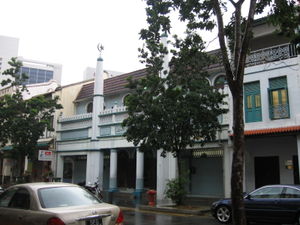- Masjid Al-Abrar
-
Coordinates: 1°16′49″N 103°50′50″E / 1.28028°N 103.84722°E
Masjid Al-Abrar at Telok Ayer Street in Chinatown of Singapore.
Masjid Al-Abrar (Malay for Al-Abrar Mosque; Chinese: 阿尔阿布拉回教堂) is one of the earliest mosques in Singapore, and is located along Telok Ayer Street in the Chinatown district within the Central Area, Singapore's central business district.
The mosque is known by three names: Masjid Al-Abrar, Kuchu Palli and Masjid Chulia. Al-Abrar is its official name, while Kuchu Palli, meaning "hut mosque", is a reflection of the mosque's first modest structure. Its location in Telok Ayer Street, in the heart of Chinatown, was where Chulia immigrants from the Coromandel Coast of South India, among the earliest immigrants to Singapore, settled when they came to Singapore -- hence, Masjid Chulia.
Contents
History
From 1827, worshippers at the Masjid Al-Abrar used a makeshift thatched hut for worship until a brick building replaced it between 1850 and 1855. An 1856 painting by Percy Carpenter, entitled Telok Ayer Street as seen from Mount Wallich, features an early visual record of the brick mosque. In 1829, the congregation of the mosque was granted a 999-year lease for the land on which the mosque stood. The lease was held in trust by Hadjee Puckery Mohamed Khatib. In 1910, five new trustees were appointed. They were K. Mohamed Eusope, Thambyappa Rarooter, S. Kanisah Maricayar, V.M. Kader Bux and J. Sultan Abdul Kader. The trustees were common across the three Chulia mosques: Masjid Al-Abrar, Masjid Jamae and Nagore Durgha.
Occupying the width of three shophouse fronts but with no five-foot way, the mosque was aligned with the street grid while also oriented towards Mecca. Inside, the mosque is essentially a one-storey prayer hall. It is much simpler than its earlier counterparts in Singapore. The four minaret-like towers that define the narrow frontage are devoid of decorative elements, except for a small onion dome on the top of each tower.
The mosque remained in this form for over a century, with only minor repairs from the 1950s to the mid-1980s. But in 1986 and again in 1989, major renovations were carried out, transforming the old mosque.
Masjid Al-Abrar was gazetted as a national monument on 29 November 1974.
Architecture
At the entrance of the mosque, the parapet that previously fringed only the central bay now ran across the whole length of the frontage. Intricately designed, the parapet features an architrave, a frieze with mouldings and panels, a balustrade and Islamic cresting echoing that found on Masjid Sultan. The courtyard that used to lie between the entrance gate and the prayer hall was covered, with part of it converted into a gallery extension. Originally single-storeyed, the prayer hall was extended to two storeys, with a gallery on the upper floor, and capped with a huge jack roof. The mosque can currently accommodate approximately 500 worshipers.
While the changes are extensive, the designers were sensitive to the original style, proportions and materials used in the old mosque were worked to ensure that the new look was graceful and cohesive.
See also
- Timeline of Islamic history
- Islamic architecture
- Islamic art
- List of mosques
- List of mosques in Singapore
References
- National Heritage Board (2002), Singapore's 100 Historic Places, Archipelago Press, ISBN 981-4068-23-3
External links
Masjid Abdul Aleem Siddique • Masjid Abdul Gaffoor • Masjid Abdul Hamid • Masjid Ahmad • Masjid Ahmad Ibrahim • Masjid Al-Abdul Razak • Masjid Al-Abrar • Masjid Al-Amin • Masjid Al-Ansar • Masjid Al-Falah • Masjid Al-Firdaus • Masjid Al-Huda • Masjid Al-Iman • Masjid Al-Istighfar • Masjid Al-Istiqamah • Masjid Al-Junied • Masjid Al-Khair • Masjid Al-Mawaddah • Masjid Al-Muttaqin • Masjid An-Nahdhah • Masjid Darul Ghufran • Masjid Darul Makmur • Masjid Diraja Teluk Blangah • Masjid En-Naeem • Masjid Hajjah Fatimah • Masjid Jamae • Masjid Malabar • Masjid Omar Kampong Melaka • Masjid Sallim Mattar • Masjid Sultan • Masjid Taha • Masjid Haji Yusoff
Category – Islam in Singapore – Mosques by country Categories:- Mosques in Singapore
- Visitor attractions in Singapore
- National Monuments of Singapore
- 1850s architecture
- Chinatown, Singapore
- Outram, Singapore
Wikimedia Foundation. 2010.



